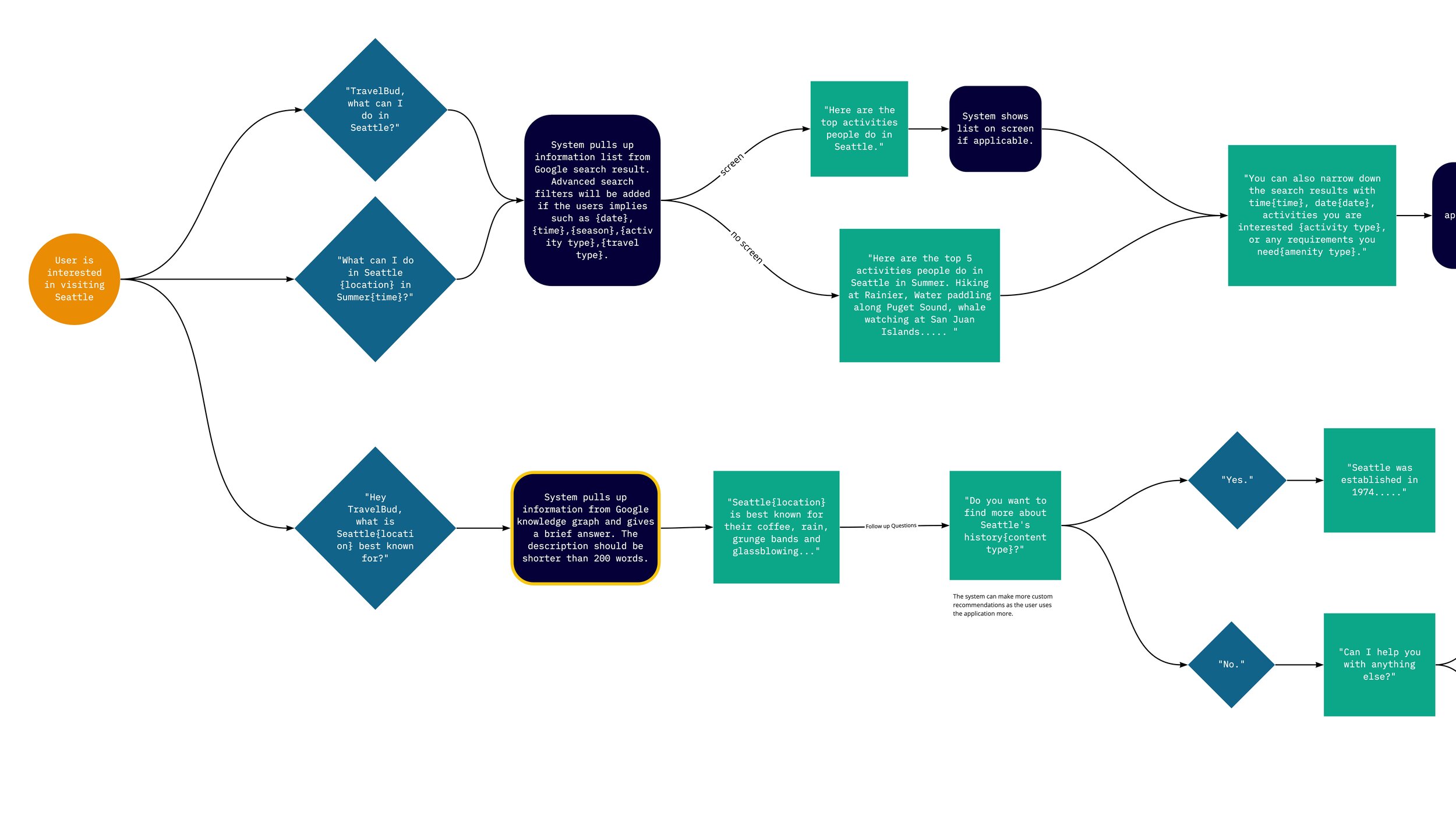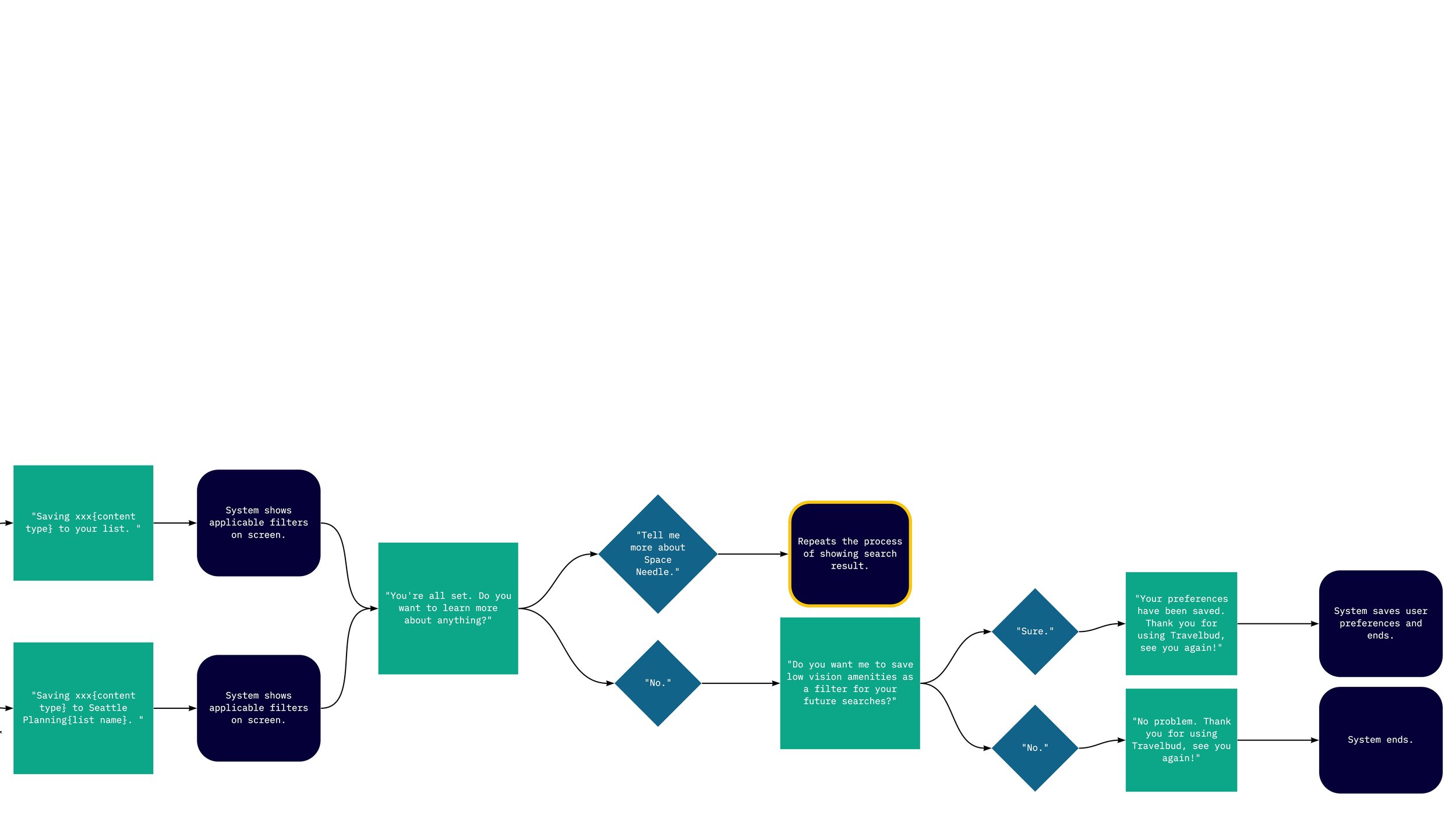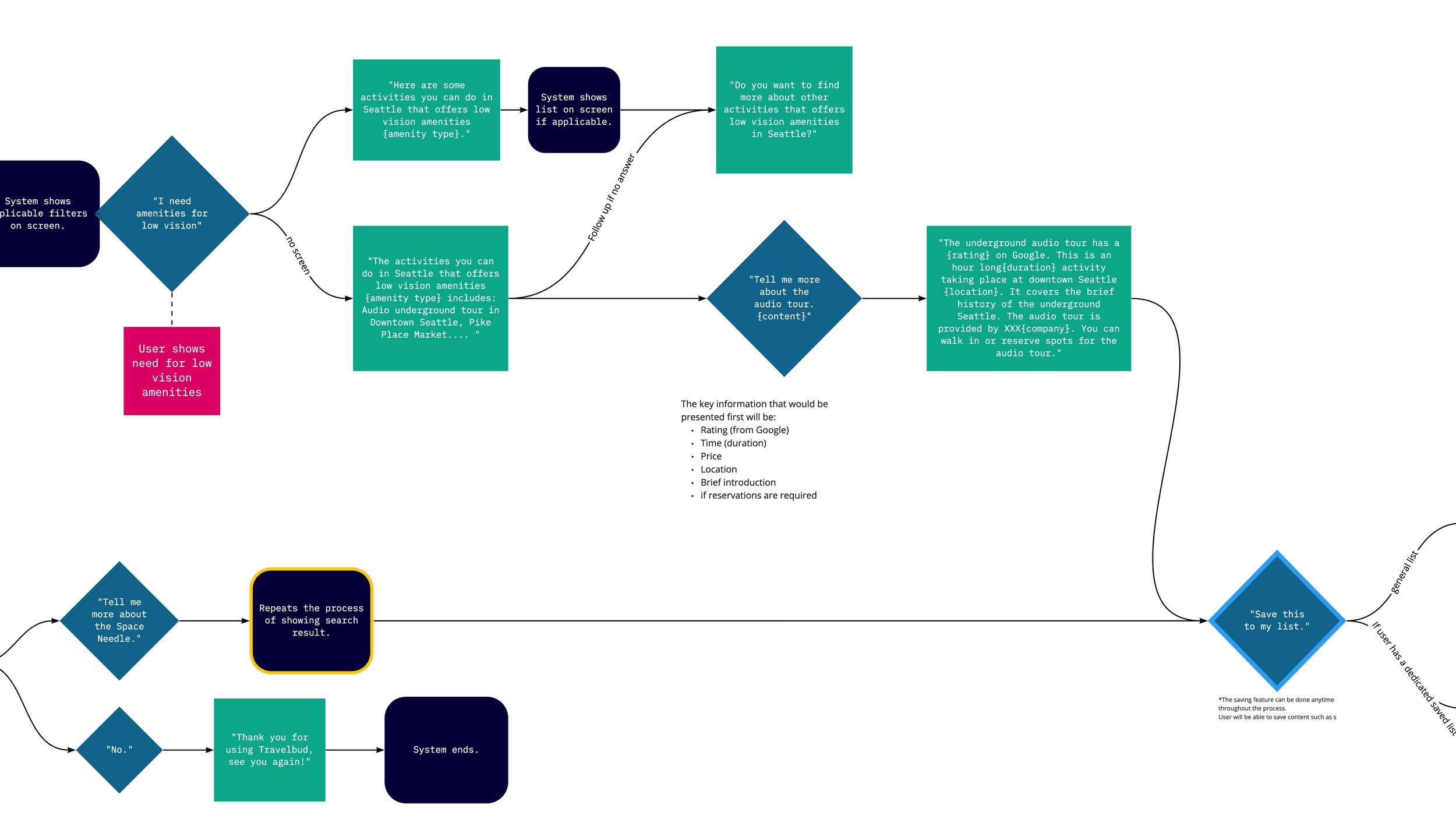Overview
TravelBud is a Voice-first application that assists people with low vision in planning travel-related activities. By accommodating the distinct needs in different stages of traditional travel journeys, TravelBud opens up new possibilities for an enhanced and personalized travel experience.
Role
UX Designer and Developer
Mainly contributed in conducting user research, designing user flows, and implementing the voice application on VoiceFlow.
Year
2020
Tools
Figma, VoiceFlow, Illustrator, Miro
Problem
TMI!
Traveling, as appealing as it sounds, can be an overwhelming experience with the amount of information required. Usually, we have to research ahead for tourist information, book various reservations, not to mention the extensive Google-mapping when we actually get there.
While there are a lot of traveling agencies and websites that supports traveling needs, most of them are online, and heavily rely on visual interfaces. There are few that looked into the low vision aspect and support voice control.
Our goal is to explore a VUI model that can support people with low vision to plan travel-related activities on tablet devices, such as researching for low-vision facilities in a tourist spot or reserving a hotel.
User Research
From this study, we could segment our main user into two groups:
This helps us gauge user needs and pain points that were felt by traveling.
These insights included: the need for accurate information, clearer communication, and an easy process.
How might we enhance the travel experience for low vision tourists?
With the amount of information, traveling can be overwhelming and frustrating. How can we help travelers with low vision navigate through a foreign city with more confidence and less effort?
Solution
Break it Down
Derived from research and a few informal interviews, we learned that although there are many aspects in a travel journey, the basics boil down to a few categories.
Aside from the general navigation process, we broke down the travel experience into 5 stages based on the different information needed. The 5 stages, in no particular order, include Planning, Booking, Traveling, Exploring, and Sharing. Depending on what the users ask or say, TravelBud would take the keywords as entry points and go through the different intent process.
General Process
The General Process, or the administrative process, describes the process for users to navigate the TravelBud application. For example, starting the application, asking for tutorials, and creating a travel plan to save information.
Once the users ask a question that is considered as entry points for one of the 5 stages, TravelBud would then go through the individual process.
Universal Commands are keywords that trigger TravelBud to go through a side conversation at any stage of the process.
1. Planning
In this stage, the main goal of the users is to find more information on a topic.
We defined "planning" as gaining more knowledge about a topic. However, at this stage, there are no follow up actions (such as booking or transaction).
Key Features
Save Content: While exploring and browsing content, users can save any content such as web pages, links, photos, guides or lists. This is helpful since the users will often be provided with multiple options but wouldn't want to investigate in details vertically yet since he/she still wants to keep browsing. This is also when the user has done enough research on a subject and would want to save it for later.
Recommendations based on saved content and past searches: After a few searches have be done, the system can based further searches results on some criteria often added by the users, such as “includes low vision amenities”.



2. Booking
In this stage, the main goal of the users is to get a service/product.
We defined that at this stage the users already have enough information on a subject and have decided to make a transaction/booking/reservation. In other words, any information acquiring behaviors not related to booking fall in the 'Planning' stage.
The main challenge of this stage is to determine which service type the users are booking since different services will require different information. The information need for different services is listed in the Service Information Table.
Key Features
Save Personal information: After gaining the users' consent, TravelBud can save personal information such as phone number, address, payment method, and special requirements for future transactions.
3. Traveling
In this stage, the main goal of the users is to move from location A to location B.
We defined that the "traveling" stage only deals with the conversations happening between location and location. So the user already has the destinations in mind, all he/she needs is the direction, navigation, and incidents that may affect travel plans.
The system can use the users' GPS location to help guide the user.
The search results, navigations are pulled from Google Map.
Key Features
Transportation Status: This can be used in two major cases. The first scenario would be when the users is asking the status of specific transportation. The second case would be if the user has book transportation ahead, for instance, a train ticket, TravelBud should remind the users if there were any delays or sudden changes. This reminder should mention once per change.
Commute: The system can save regular routes of the users for faster access in the future. Such as going to the railway station from the user's hotel
Filter Options: In addition to providing navigation, TravelBud is able to alter the search results according to advanced criteria such as transportation type, road condition, slope, if a fee is required or if it is service animal friendly.
4. Exploring
In this stage, the main goal of the users is to get updated recommendations and suggestions on the spot.
The user has already arrived at the tourist location they wanted to visit. In this stage, they would be interested in learning more about things they can do, exploring if there are events happening around, and visit other spots in the nearby area that are similar to their interest. Compared with the Planning stage, where the system would retrieve more general results, the explore stage would focus more on finding specific events close to the user’s location.
The system can use the users' GPS location to help guide the user.
Key Features
Need Locator: Users can ask TravelBud where to find nearby restaurants, stores, or public restrooms in case the user needs any of them. Travelbud brings up the three closest locations and the user can filter for specific types of stores or restaurants or browse.
Location Information: TravelBud is able to utilize GPS data to tell where the user is located. If the user asks TravelBud about where they are, they can hear more about the neighborhood or landmark they're in.
5. Sharing
In this stage, the main goal of the user is to share captured videos or pictures
The user has captured media of the sites they have visited, either with the help of the assistant or by themselves. At this point, they can share it on certain social media websites such as Twitter, Instagram, or Facebook. They can also send them to people individually.
Key Features
Instant Share: The user can select a photo, chosen on-screen by themselves or chosen with the help of the assistant. Once one or multiple are selected, they can choose which social media platform or person to send it to. Users can also add optional messages.
Intents, Slots, and Utterances
Intents are the actions and goals a user is trying to accomplish; Slots are variables that relate and enhances an intent; Utterances are the specific phrases users say to make a request. Since there are many variations of answers the user might say, we created this table to document the possible utterances.
The full table can be found here.
TravelBud Persona
Sample User Journey
Booking a trip to Seattle.
The video below shows a sample journey of a user booking a trip to Seattle using verbal instructions. The voice application was implemented on VoiceFlow.
Reflection
The shortest distance between two points is not a straight line.
At the beginning of this project, the scope of “Enhancing the travel experience for people with low vision“ was daunting.
The greatest lesson in this project for me is getting over the fear that solutions will never work fully on the first try. I’m really proud that we went through iterations of trial and error, not aiming to design the “final perfect solution” but to make our design decisions more informed each round.
The project is still very big and it would take many tries to implement our idea.
Looking forward, there are still many UX challenges worth digging into:
How might we… add collaborators for family and friends on the same trip plan?
How might we… go fully voice control?
The full project Miro board can be found here with the password: lvtuserflow





















